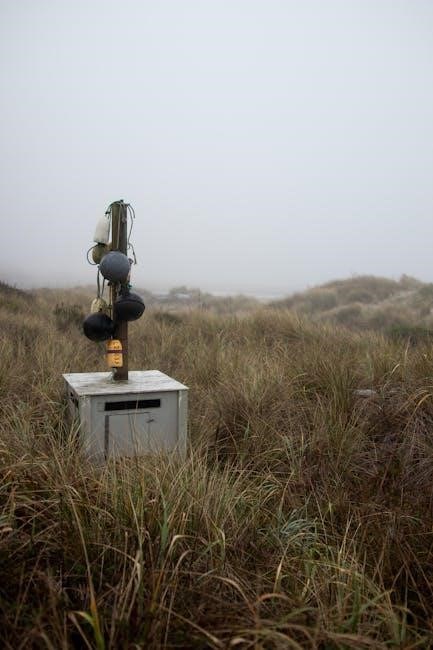The ProStart Remote Starter system offers advanced features for both automatic and manual transmission vehicles, including SmartStart integration and enhanced safety features. Proper installation ensures optimal reliability and seamless functionality.
Overview of the ProStart Remote Starter System
The ProStart Remote Starter System is a cutting-edge solution designed for both automatic and manual transmission vehicles. It offers advanced features such as SmartStart module integration, idle mode settings, and engine run time configuration. The system ensures enhanced convenience, security, and reliability, with compatibility across various vehicle types, including diesel engines. Its user-friendly interface and programmable options make it a versatile choice for modern vehicles, providing seamless remote start functionality while maintaining safety and performance standards. Proper installation is crucial to unlock its full potential.
Importance of Proper Installation
Proper installation of the ProStart Remote Starter System is essential for optimal performance and safety. Incorrect wiring or connections can lead to system malfunctions, vehicle damage, or security vulnerabilities; Following the installation manual ensures compatibility with your vehicle’s electrical and transmission systems. It also guarantees that safety features, such as the Safe Start child safety feature, function correctly. A well-executed installation prevents issues like premature battery drain or unauthorized vehicle access, ensuring a reliable and secure remote start experience.
Pre-Installation Steps
Before installing the ProStart Remote Starter, ensure compatibility with your vehicle and prepare necessary tools. Review the manual and disconnect the battery for safety.
Understanding Vehicle Compatibility
Ensure your vehicle is compatible with the ProStart Remote Starter system. Most models support automatic transmissions, while specific systems like the CT-3471 TW accommodate manual transmissions. Diesel vehicles require activation of the glow-plug ignition circuit before installation. Always verify compatibility using the ProStart tech sheet for your vehicle. Testing OEM door switch contacts is crucial for manual transmissions to ensure proper function. Visit www.ProStart.org for detailed compatibility guides and model-specific instructions.
Preparation of Tools and Materials
Before starting, gather essential tools and materials. You’ll need a multimeter, wire strippers, connectors, and a soldering iron. Ensure you have the correct wiring diagram and installation manual for your ProStart model. Disconnect the vehicle’s battery to prevent electrical shocks. Keep safety gloves and goggles handy. Organize all components, including the remote starter module, wiring harness, and fuses. Double-check that you have the correct fuse ratings for your vehicle. Having all materials ready ensures a smooth installation process and minimizes potential errors.
Reviewing the Installation Manual
Thoroughly review the ProStart installation manual to understand the system’s requirements and specifications. The manual provides detailed step-by-step instructions, wiring diagrams, and safety precautions. Familiarize yourself with the vehicle’s electrical system and the ProStart module’s features. Pay attention to model-specific instructions, such as those for CT-3200 or CT-3371 systems. Ensure you understand the safety protocols, like disconnecting the battery before starting work. The manual also outlines troubleshooting tips and advanced configurations. Reading it carefully ensures a smooth and error-free installation process.
Installation Process for Automatic Transmission Vehicles
The ProStart system for automatic transmissions involves connecting the remote starter module, following detailed wiring diagrams, and programming the system to ensure compatibility and smooth operation.
Connecting the Remote Starter Module
Begin by identifying the ProStart remote starter module and its ports. Connect the ignition switched power, constant power, and starter circuit wires according to the wiring diagram. Ensure the module is securely mounted in an accessible location. For automatic transmissions, connect the transmission neutral safety wire to prevent accidental starting in gear. Properly route and secure all wires to avoid interference. Finally, connect the antenna and any optional accessories like the SmartStart module for advanced features. This step ensures the system is ready for programming and testing. Always refer to the specific model’s instructions for precise connections.
Wiring Diagram and Connections
Refer to the ProStart wiring diagram for precise connections. Identify the ignition switched power, constant power, and starter circuit wires. Connect the ignition wire to the vehicle’s keyed ignition source and the constant power wire to the battery. The starter wire links to the vehicle’s starter motor circuit. For automatic transmissions, connect the transmission safety wire to ensure the vehicle is in park. Secure all connections with heat-shrink tubing or solder for reliability. Double-check the wiring diagram to avoid mismatches, which could damage the system or vehicle. Proper wiring ensures safe and efficient remote start functionality;
Programming the Remote Starter System
Programming the ProStart remote starter involves synchronizing the remote with the module. Press and hold the system’s programming button until the LED flashes. Use the key fob to complete the pairing process. Configure settings like engine run time and idle mode using the remote or module buttons. Test the system by starting the engine remotely to ensure proper functionality; Refer to the manual for specific sequences and timing. Proper programming ensures all features work seamlessly and safely, including automatic transmission lock and smart start integration.
Installation Considerations for Manual Transmission Vehicles
Manual transmissions require specific steps to ensure safe operation. Test OEM door switch contacts and verify wiring connections. Special requirements may apply to prevent accidental starts.
Testing OEM Door Switch Contacts
Testing the vehicle’s OEM door switch contacts ensures proper operation of the remote starter system. For manual transmissions, verify that the door switch contacts function correctly to prevent accidental starts. Check the contacts using a multimeter to ensure they open and close properly when the door is opened or closed. If the contacts fail to operate, consult the vehicle’s repair manual for troubleshooting or replacement. Properly functioning door switches are essential for the remote starter’s safety and security features to work effectively, especially in manual transmission vehicles.
Special Requirements for Manual Transmissions
Manual transmission vehicles require additional considerations during remote starter installation. Ensure the system is configured to prevent accidental starts while in gear. Use a neutral safety switch or equivalent to verify the vehicle is in neutral before starting. Programming may involve setting manual mode after the first successful start. Always refer to the installation guide for specific instructions to maintain safety and functionality. Proper configuration ensures the remote starter operates reliably without risking unintended movement of the vehicle.

Safety Precautions and Best Practices
Always disconnect the battery before installation to prevent electrical hazards. Remove fuses during initial steps and reconnect them only after completion. Ensure all wire connections are secure and properly insulated to avoid malfunctions.
Disconnecting the Battery Before Installation
Disconnecting the battery is a crucial safety step before starting the installation. Locate the vehicle’s battery and use an appropriate wrench to loosen the terminal clamp. Remove the negative (black) cable first to prevent electrical shock. Ensure the battery is completely disconnected to avoid power surges. This step prevents accidental engine start-ups and protects the electrical system from damage. Always wait a few minutes for residual power in the vehicle’s systems to dissipate before proceeding. Never skip this step for safety reasons.
Ensuring Proper Wire Connections
Proper wire connections are vital for the remote starter system to function correctly. Always use the provided wiring diagram to identify the correct terminals. Match the wires by color and function, ensuring secure connections. Use heat shrink tubing or electrical tape to insulate and protect splices. Avoid loose or corroded connections, as they can cause malfunctions. Test each connection with a multimeter for continuity and proper voltage. Never skip this step, as faulty connections can lead to system failures or damage to the vehicle’s electrical system. Precision is key for reliable performance.

Advanced Features and Configuration
The ProStart system supports advanced features like SmartStart module integration for enhanced remote start functionality. Configure settings such as idle mode, engine run time, and priority door access for convenience and security.
SmartStart Module Integration
Integrating the SmartStart module enhances the ProStart remote starter’s functionality. Connect the module to the designated SmartStart port on the remote starter unit to unlock advanced features. This integration allows for smartphone app control, real-time status updates, and customizable settings. Ensure proper wiring and refer to the wiring diagram for accurate connections. After installation, sync the module with your smartphone to access features like engine run time adjustment and idle mode settings. Always consult the installation manual for specific instructions and troubleshooting tips to ensure seamless integration and optimal performance. Proper configuration guarantees enhanced convenience and security for your vehicle’s remote start system.
Setting Up Idle Mode and Engine Run Time
The ProStart remote starter allows you to configure Idle Mode and engine run time for optimal performance. Idle Mode enables the engine to run without the vehicle being in gear, while engine run time sets how long the engine operates after a remote start. These settings can be adjusted via the remote starter module or through the SmartStart app. Default settings are typically 15-30 minutes, but you can customize them based on your needs. Adjustments are essential for extreme weather conditions or specific vehicle requirements. Always refer to the installation manual for detailed instructions on configuring these features properly.

Troubleshooting Common Issues
Troubleshooting common issues involves diagnosing remote start failures, wiring problems, and sensor malfunctions; Always check connections, review the manual, and test components to resolve issues effectively.
Diagnosing Remote Start Failures
Diagnosing remote start failures involves checking wiring connections, sensor functionality, and system settings. Common issues include faulty brake pedal sensors, hood pin switches, or incorrect wiring. Start by reviewing the wiring diagram to ensure all connections are secure and properly routed. Test the remote starter’s basic functions, such as ignition activation and engine crank. If issues persist, consult the installation manual or reset the system to default settings. Always verify that safety features, like the brake interlock, are functioning correctly.
Resolving Wiring and Connection Problems
Wiring issues are common during remote starter installation. Verify all connections match the wiring diagram, ensuring polarity is correct. Check for loose or corroded wires, and secure them properly. Use a multimeter to test voltage at critical points, such as the ignition and starter circuits. If connections are misconfigured, refer to the installation manual for corrections. For advanced systems like the ProStart CT-3200 or CT-3371, ensure the SmartStart module is properly integrated. Addressing wiring problems early prevents system malfunctions and ensures reliable performance.

Final Testing and System Verification
Test the remote start functionality to ensure proper operation. Verify safety features, such as automatic shut-off, are functioning correctly. Validate all wire connections for reliability and security.
Testing Remote Start Functionality
After installation, test the remote start by pressing the button to ensure the engine starts and runs smoothly. Check the remote’s range and functionality. Verify that the vehicle starts in park or neutral and does not engage gears. Test the automatic shut-off feature by opening the door or turning the key. Ensure all safety features, like the brake pedal override, work correctly. If issues arise, review connections and settings before retesting. Confirm the system returns to a safe state if any malfunction is detected.
Verifying Safety and Security Features
Ensure the remote starter’s safety and security features are functioning correctly. Test the brake pedal override to confirm the engine shuts off when the brake is pressed. Verify that the vehicle does not start in gear and automatically returns to a safe state if a malfunction occurs. Check the encryption for secure communication between the remote and vehicle. Test the passive or active arming to ensure the system is secure. Confirm all safety features, like automatic shut-off, work as intended for added protection.

